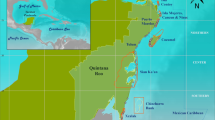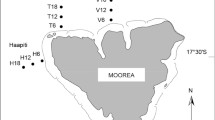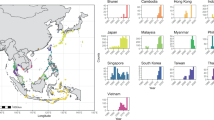Abstract
Published and unpublished long-term studies are assembled to examine trends in coral cover and the dependence of change in coral cover on the initial coral cover in Kāne‘ohe Bay over the last 44 yr. Each study showed there had been periods of increase in coral cover in the bay and showed that the rate of change in cover has been inversely dependent on the initial cover at a site. When coral cover is high on upper reef slopes, the fragile structure of reefs in this sheltered bay often collapses, resulting in a decrease in coral cover. The rate of change in coral cover was also inversely dependent on cover in one of the two studies that included analysis of reef-flat corals; the cause of decrease in cover in this habitat is thought to be attributable to particularly low sea levels in Hawai‘i in the late 1990s and 2009–2010. The inverse relationship between initial coral cover and change in cover, and the intersections of the regression lines of these variables with the x-axis at intermediate values of coral cover, is indicative of resilience in this ecosystem over the last 44 yr. In the 1970s, the invasive macroscopic green alga Dictyosphaeria cavernosa covered a high percentage of coral habitat and commonly displaced corals from the reef slope and outer reef flats; the change was cited as an example of a phase shift on a reef. This alga has virtually disappeared from the bay, thus increasing the space available to corals; its disappearance is coincident with the increase in coral cover. Other species of macroalgae, including alien species, have not replaced D. cavernosa as major space competitors. The increase in coral cover and virtual disappearance of D. cavernosa constitute an example of a phase-shift reversal.









Similar content being viewed by others
References
Adjeroud M, Michonneau F, Edmunds PJ, Chancerelle Y, Lison de Loma T, Penin L, Thibaut L, Vidal-Dupiol J, Salvat B, Galzin R (2009) Recurrent disturbances, trajectories, and resilience of coral assemblages on a South Central Pacific reef. Coral Reefs 28:775–780
Aeby GS, Ross M, Williams GJ, Lewis TD, Work TM (2010) Disease dynamics of Montipora white syndrome within Kaneohe Bay, Oahu, Hawaii: distribution, seasonality, virulence and transmissibility. Dis Aquat Organ 91:1–8
Bahr KD, Jokiel PL, Rodgers KS (2015) The 2014 coral bleaching and freshwater flood events in Kaneohe Bay, Hawaii. PeerJ 3:e1136
Bak RPM (1975) Ecological aspects of the distribution of reef corals in the Netherlands Antilles. Contributions to Zoology 45:181–190
Banner AH (1968) A fresh-water “kill” on the coral reefs of Hawaii. Technical Report No. 15, Hawaii Institute of Marine Biology, Kaneohe, Hawaii, 29 pp
Banner AH, Bailey JH (1970) The effects of urban pollution upon a coral reef system, a preliminary report. Technical Report No. 25, Hawaii Institute of Marine Biology, Kaneohe, Hawaii, 66 pp
Bellwood DR, Hughes TP, Folke C, Nyström M (2004) Confronting the coral reef crisis. Nature 429:827–833
Bellwood DR, Hughes TP, Hoey AS (2006) Sleeping functional group drives coral-reef recovery. Curr Biol 16:2434–2439
Birkeland C, Green A, Fenner D, Squair C, Dahl AL (2013) Substratum stability and coral reef resilience: insights from 90 years of disturbances on a reef in American Samoa. Micronesica 6:1–16
Brown BE, Dunne RP, Phongsuwan N, Somerfield PJ (2011) Increased sea level promotes coral cover on shallow reef flats in the Andaman Sea, eastern Indian Ocean. Coral Reefs 30:867
Bruno JF, Selig ER (2007) Regional decline of coral cover in the Indo-Pacific: timing, extent, and subregional comparisons. PLoS One 2:e711
Carpenter RC, Edmunds PJ (2006) Local and regional scale recovery of Diadema promotes recruitment of scleractinian corals. Ecol Lett 9:271–280
Cheal AJ, MacNeil MA, Cripps E, Emslie MJ, Jonker M, Schaffelke B, Sweatman H (2010) Coral–algal phase shifts or reef resilience: links with diversity and functional roles of herbivorous fishes on the Great Barrier Reef. Coral Reefs 29:1005–1015
Conklin EJ, Stimson JS (2004) An attempt to increase numbers of herbivorous fishes as a means of controlling populations of fleshy macroalgae on coral reefs in Kāne‘ohe Bay, Hawai‘i. Pacific Science 58:189–200
Connell JH (1973) Population ecology of reef-building corals. In: Jones OA, Endean R (eds) Biology and geology of coral reefs, Biology 1, Vol. 2 Academic Press, New York, pp 205–245
Connell JH (1978) Diversity in tropical rain forests and coral reefs. Science 199:1302–1310
Connell JH, Hughes TP, Wallace CC (1997) A 30-year study of coral abundance, recruitment, and disturbance at several scales in space and time. Ecol Monogr 67:461–488
Connell JH, Hughes TP, Wallace CC, Tanner JE, Harms KE, Kerr AM (2004) A long-term study of competition and diversity of corals. Ecol Monogr 74:179–210
Côté IM, Gill JA, Gardner TA, Watkinson AR (2005) Measuring coral reef decline through meta-analysis. Philos Trans R Soc Lond B Biol Sci 360:385–395
Cox DC, Fan PF, Chave KE, Clutter RI, Gundersen KR, Burbank NC, Lau LS, Davidson JR (1973) Estuarine pollution in the State of Hawaii. Vol 2: Kaneohe Bay study. Technical Report No. 31, Water Resources Research Center. University of Hawaii, Honolulu
De’ath G, Fabricius KE, Sweatman H, Puotinen M (2012) The 27-year decline of coral cover on the Great Barrier Reef and its causes. Proc Natl Acad Sci USA 109:17995–17999
Diaz-Pulido G, McCook L, Dove S, Berkelmans R, Roff G, Kline DI, Weeks S, Evans RD, Williamson DH, Hoegh-Guldberg O (2009) Doom and boom on a resilient reef: climate change, algal overgrowth and coral recovery. PLoS One 4:e5239
Done TJ (1992) Phase shifts in coral reef communities and their ecological significance. Hydrobiologia 247:121–132
Done T, Turak E, Wakeford M, DeVantier L, McDonald A, Fisk D (2007) Decadal changes in turbid-water coral communities at Pandora Reef: loss of resilience or too soon to tell? Coral Reefs 26:789–805
Edmondson CH (1928) The ecology of Hawaiian coral reefs. Bernice P. Bishop Museum Bulletin 45:1–64
Edmunds PJ, Carpenter RC (2001) Recovery of Diadema antillarum reduces macroalgae cover and increases abundance of juvenile corals on a Caribbean reef. Proc Natl Acad Sci USA 98:5067–5071
Firing YL, Merrifield MA, Schroeder TA, Qiu B (2004) Interdecadal sea level fluctuations at Hawaii. J Phys Oceanogr 34:2514–2524
Gardner TA, Côté IM, Gill JA, Grant A, Watkins AR (2003) Long-term region-wide declines in Caribbean corals. Science 301:958–960
Gochfeld DJ, Aeby GS (1997) Control of populations of the coral-feeding nudibranch Phestilla sibogae by fish and crustacean predators. Mar Biol 130:63–69
Graham NAJ, Nash KL, Kool JT (2011) Coral reef recovery dynamics in a changing world. Coral Reefs 30:283–294
Guillemot N, Chabanet P, Le Pape O (2010) Cyclone effects on coral reef habitats in New Caledonia (South Pacific). Coral Reefs 29:445–453
Halford A, Cheal AJ, Ryan D, Williams DMB (2004) Resilience to large-scale disturbance in coral and fish assemblages on the Great Barrier Reef. Ecology 85:1892–1905
Holling CS (1973) Resilience and stability of ecological systems. Annu Rev Ecol Syst 4:1–23
Holthus P (1986) Structural reefs of Kaneohe Bay: an overview. In: Jokiel PH, Richmond RH, Rogers RA (eds), Coral reef population biology. Technical Report 37, Hawaii Institute of Marine Biology, Honolulu, Hawaii, pp 19–34
Hughes TP, Bellwood DR, Folke C, Steneck RS, Wilson J (2005) New paradigms for supporting the resilience of marine ecosystems. Trends Ecol Evol 20:380–386
Hughes TP, Bellwood DR, Baird AH, Brodie J, Bruno JF, Pandolfi JM (2011) Shifting base-lines, declining coral cover, and the erosion of reef resilience: comment on Sweatman et al. (2011). Coral Reefs 30:653–660
Hunter CL, Evans CW (1995) Coral reefs in Kaneohe Bay, Hawaii: two centuries of western influence and two decades of data. Bull Mar Sci 57:501–515
Idjadi JA, Lee SC, Bruno JF, Precht WF, Allen-Requa L, Edmunds PJ (2006) Rapid phase-shift reversal on a Jamaican coral reef. Coral Reefs 25:209–211
Jokiel PL, Brown EK (2004) Global warming, regional trends and inshore environmental conditions influence coral bleaching in Hawaii. Glob Chang Biol 10:1627–1641
Jokiel PL, Hunter CL, Taguchi S, Watarai L (1993) Ecological impact of freshwater “reef kill” on the reefs of Kaneohe Bay, Oahu, Hawaii. Coral Reefs 12:177–184
Lang J (1973) Interspecific aggression by scleractinian corals. 2. Why the race is not only to the swift. Bull Mar Sci 23:260–279
Loya Y (1972) Community structure and species diversity of hermatypic corals at Eilat, Red Sea. Mar Biol 13:100–123
Loya Y (1976) Recolonization of Red Sea corals affected by natural catastrophes and man-made perturbations. Ecology 57:272–289
Maragos JE (1972) A study of the ecology of Hawaiian reef corals. Ph.D. dissertation, University of Hawaii, Honolulu, HI
Maragos JE, Evans CW, Holthus P (1985) Reef corals in Kaneohe Bay six years before and after termination of sewage (Oahu, Hawaiian Archipelago). Proc 5th Int Coral Reef Symp 4:189–194
Mayor A (1924) Structure and ecology of Samoan reefs. Carnegie Institution of Washington Publication 340, Department of Marine Biology, 19:1–25
Miller RJ, Adams AJ, Ogden NB, Ogden JC, Ebersole JP (2003) Diadema antillarum 17 years after mass mortality: is recovery beginning on St. Croix. Coral Reefs 22:181–187
Mumby PJ, Harborne AR, Williams J, Kappel CV, Carrie V, Brumbaugh DR, Micheli F, Holmes KE, Dahlgren CP, Paris CB, Blackwell PG (2007) Trophic cascade facilitates coral recruitment in a marine reserve. Proc Natl Acad Sci USA 104:8362–8367
Mumby PJ, Dahlgren CP, Harborne AR, Kappel CV, Micheli F, Brumbaugh DR, Holmes KE, Mendes JM, Broad K, Sanchirico JN, Buch K, Box S, Stoffle RW, Gill AB (2006) Fishing, trophic cascades, and the process of grazing on coral reefs. Science 311:98–101
Myhre S, Acevedo-Gutiérrez A (2007) Recovery of sea urchin Diadema antillarum populations is correlated to increased coral and reduced macroalgal cover. Mar Ecol Prog Ser 329:205–210
Nyström M, Graham NAJ, Lokrantz J, Norström AV (2008) Capturing the cornerstones of coral reef resilience: linking theory to practice. Coral Reefs 27:795–809
Pearson RG (1974) Recolonization by hermatypic corals of reefs damaged by Acanthaster. Proc 2nd Int Coral Reef Symp 2:207–215
Rinkevich B (2005) What do we know about Eilat (Red Sea) reef degradation? A critical examination of the published literature. J Exp Mar Bio Ecol 327:183–200
Rodgers SK, Jokiel PL, Brown EK, Hau S, Sparks R (2015) Over a decade of change in spatial and temporal dynamics of Hawaiian coral reef communities. Pacific Science 69:1–13
Rogers CS, Miller J (2006) Permanent ‘phase shifts’ or reversible declines in coral cover? Lack of recovery of two coral reefs in St. John, US Virgin Islands. Mar Ecol Prog Ser 306:103–114
Roy KJ (1970) Change in bathymetric configuration, Kaneohe Bay, Oahu, 1882–1969. Hawaii Institute of Geophysics Report 70-15, University of Hawaii, Honolulu, 226 pp
Scheffer M, Carpenter S, Foley JA, Folke C, Walker B (2001) Catastrophic shifts in ecosystems. Nature 413:591–596
Smith LD, Gilmour JP, Heyward AJ (2008) Resilience of coral communities on an isolated system of reefs following catastrophic mass bleaching. Coral Reefs 27:197–205
Smith SV, Chave KE, Kam DTO (1973) Atlas of Kaneohe Bay: a reef ecosystem under stress. The University of Hawaii Sea Grant Program, Honolulu, Hawaii, p 128
Smith SV, Kimmerer WJ, Laws EA, Brock RE, Walsh TW (1981) Kaneohe Bay sewage diversion experiment: perspectives on ecosystem responses to nutritional perturbation. Pacific Science 35:279–395
Soegiarto A (1972) The role of benthic algae in the carbonate budget of the modern reef complex, Kaneohe Bay. Ph.D. dissertation, University of Hawaii. Honolulu, HI
Stimson J (2015) Long-term record of nutrient concentrations in Kāne‘ohe Bay, Oahu, Hawai‘i and its relevance to onset and end of a phase shift involving an indigenous alga, Dictyosphaeria cavernosa. Pacific Science 69:319–339
Stimson J, Conklin E (2008) Potential reversal of a phase shift: the rapid decrease in the cover of the invasive green macroalga Dictyosphaeria cavernosa Forsskål on coral reefs in Kāne‘ohe Bay, Oahu, Hawai‘i. Coral Reefs 27:717–726
Stimson J, Larned ST, Conklin E (2001) Effects of herbivory, nutrient levels and introduced algae on the distribution and abundance of the invasive macroalga Dictyosphaeria cavernosa in Kaneohe Bay. Hawaii. Coral Reefs 19:343–357
Sweatman H, Delean S, Syms C (2011) Assessing loss of coral cover on Australia’s Great Barrier Reef over two decades, with implications for longer-term trends. Coral Reefs 30:521–531
Williams GJ, Aeby GH, Cowie ROM, Davy SK (2010) Predictive modeling of coral disease distribution within a reef system. PLoS One 5:e9264
Yamaguchi M (1975) Sea level fluctuations and mass mortalities of reef animals in Guam, Mariana Islands. Micronesica 11:227–243
Acknowledgements
I wish to thank the Department of Zoology, University of Hawai‘i and the Hawai‘i Institute of Marine Biology for access to facilities. The 1992 and 1996–1997 studies were accomplished with funding from the Sea Grant College Program and with the help of a number of undergraduates, Eric Conklin and Scott Larned. I wish to thank Ku’ulei Rodgers and co-workers for providing access to the data on the 1999 estimates of cover at the Maragos sites, and to thank Drs. Julie Brock and Steve Coles for commenting on a draft of the manuscript.
Author information
Authors and Affiliations
Corresponding author
Additional information
Communicated by Ecology Editor Dr. Stuart A. Sandin
Rights and permissions
About this article
Cite this article
Stimson, J. Recovery of coral cover in records spanning 44 yr for reefs in Kāne‘ohe Bay, Oa‘hu, Hawai‘i. Coral Reefs 37, 55–69 (2018). https://doi.org/10.1007/s00338-017-1633-2
Received:
Accepted:
Published:
Issue Date:
DOI: https://doi.org/10.1007/s00338-017-1633-2




